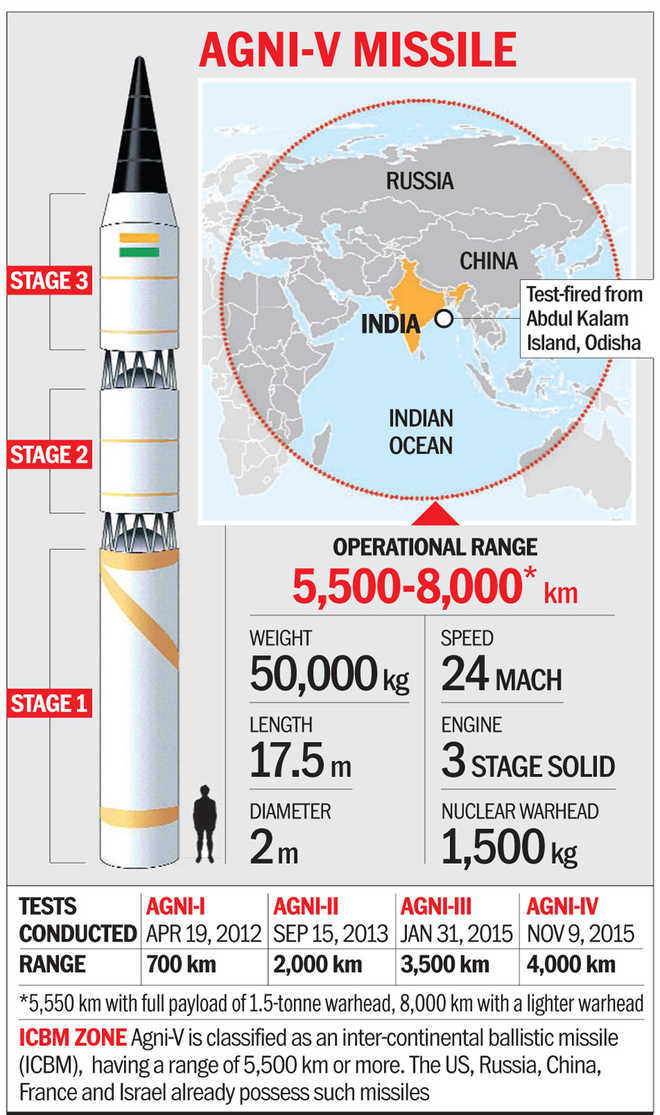Note4Students
From UPSC perspective, the following things are important :
Prelims level: Hypersonic Glide Vehicle, ICBM
Mains level: Hypersonic Glide Missiles

Though inducted over three years ago, India’s foremost Agni 5 ballistic missile was tested for the first time after reports that China had tested a new hypersonic missile.
What is the Agni 5 missile?

- Agni 5 is India’s long-range surface-to-surface ballistic missile, which can hit a target with a precision that is 5,000 km
- The nuclear-capable missile is India’s contender for the Intercontinental Ballistic Missile (ICBM).
- Its range puts almost the entire China within the missile’s target range.
- Though the government has claimed that it has a maximum range of around 5,000 km, several reports suggest that it can hit targets as distant as 8,000 km.
- The nuclear capable missile can carry a warhead of around 1,500 kg and has a launch weight of 50,000 kg, making it one of the most potent missiles in the country.
Note: Officially an ICBM needs a missile to have a range of at least 5,500 km.
History of Agni Missiles
- India began testing the Agni series of missiles in 1989 with the first test for Agni 1, an Intermediate-Range Ballistic Missile, with a range of around 1,000 km.
- At that time only the US, the erstwhile Soviet Union, China, France and Israel, had IRBM technology.
- Since then, DRDO labs have continued to work on it, bringing the latest available Agni 5 to its present capability.
- In addition to the IRBM-capable nations, only North Korea and the UK have ICBM technology at the moment.
Why is it important for India?
- The success of AGNI missiles is in line with India’s stated policy to have ‘credible minimum deterrence’ that underpins the commitment to ‘No First Use’.
- What makes Agni 5 agile is that it is a “canisterised” missile. It means that the missile can be launched from road and rail platforms, making it easier for it to be deployed and launched at a quicker pace.
- The canisterisation also gives the missile a longer shelf life, protecting it from the harsher climatic conditions.
- While India is among the handful of nations with ICBM capability.
- The next generation of the missile, Agni VI, under development, is expected to have a range of around 8,000 km.
What is a Hypersonic Glide Vehicle that China tested?
- HGV is nuclear capable missile, which circled the earth before moving towards its target, missing it by two dozen miles.
- It is launched by a rocket which moves in the Earth’s lower orbit, at more than five times to 25 times the speed of sound.
- The vehicle is capable of carrying nuclear payloads, which gives the launching country the strategic capacity to attack almost any target across the world.
How is HGV different from an ICBM?
- A hypersonic glide vehicle orbits the earth at a lower height, and is manoeuvrable as compared to ICBM.
- The ability to change track or target, mid-trajectory, along with the speed, makes them tougher to track and defend against.
- The manoeuvrability provides them in-flight updates to attack a different target than originally planned.
- They possess ability to fly at unpredictable trajectories, these missiles will hold extremely large areas at risk throughout much of their flights.
Which countries have hypersonic technology?
- Apart from China, the US and Russia are working on the technology.
- France and India are working together for gaining the capability.
Concerns about China developing such technology
- China might have left the US behind in hypersonic capability.
- It is being perceived as a Sputnik moment (first Russian space mission widely envied by the US).
- A hypersonic attack could occur with very little warning time. The unpredictable trajectory would give them an advantage.
Another concern: Increasing Proliferation
- Globally the main concern is that once the technology is successfully established by even one country, it would lead to a larger race for the capability and its eventual proliferation.
- The more that hypersonic missiles proliferate into the hands of additional nations, the more paths develop for crises.
UPSC 2022 countdown has begun! Get your personal guidance plan now! (Click here)
Get an IAS/IPS ranker as your 1: 1 personal mentor for UPSC 2024
